

Neurotransmitter Release: The Last Millisecond in the Life of a Synaptic Vesicle. Neurotransmitter Release: The Last Millisecond in the Life of a Synaptic Vesicle. Augustin I.
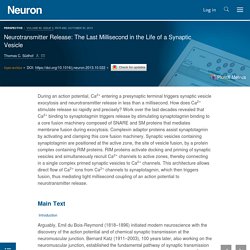
Rosenmund C. Südhof T.C. Neurotransmitters, Synapses, and Impulse Transmission - Molecular Cell Biology - NCBI Bookshelf. Nerve terminal nanofilaments control brain signalling. New drug raises hopes of reversing memory loss in old age. An experimental drug that bolsters ailing brain cells has raised hopes of a treatment for memory loss, poor decision making and other mental impairments that often strike in old age.
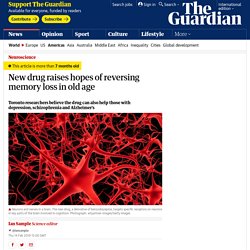
The drug could be taken as a daily pill by over-55s if clinical trials, which are expected to start within two years, show that the medicine is safe and effective at preventing memory lapses. Tests in the lab showed that old animals had far better memory skills half an hour after receiving the drug. After two months on the treatment, brain cells which had shrunk in the animals had grown back, scientists found. Etienne Sibille, at the Centre for Addiction and Mental Health in Toronto, said the treatment was aimed not only at the “normal” cognitive decline that leads to senior moments, but at memory loss and mental impairments that commonly afflict people with depression, schizophrenia and Alzheimer’s disease. Neuroanthropology. Lucid dreams and metacognition: Awareness of thinking - awareness of dreaming. Brain researchers discover similarities between dreaming and wakefulness To control one’s dreams and to live out there what is impossible in real life – a truly tempting idea.
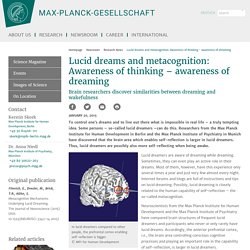
Some persons – so-called lucid dreamers –can do this. Researchers from the Max Planck Institute for Human Development in Berlin and the Max Planck Institute of Psychiatry in Munich have discovered that the brain area which enables self-reflection is larger in lucid dreamers. Thus, lucid dreamers are possibly also more self-reflecting when being awake. Cells & Circuits. The Human Brain Is a Time Traveler. Randy Buckner was a graduate student at Washington University in st.

Louis in 1991 when he stumbled across one of the most important discoveries of modern brain science. For Buckner — as for many of his peers during the early ’90s — the discovery was so counterintuitive that it took years to recognize its significance. Why our sense of time speeds up as we age — and how to slow it down. Face-selective brain region continues to grow in adulthood. Faces are important to us.
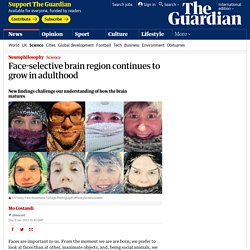
From the moment we are are born, we prefer to look at faces than at other, inanimate objects, and, being social animals, we encounter faces every day of our lives. The face is the first thing we look to when identifying other people; faces also convey emotions, informing us of peoples’ mood, and from them we can usually determine a person’s sex and, sometimes, roughly how old they are. Eye movements can also reveal to us something about another person’s intentions. Germs in Your Gut Are Talking to Your Brain. Scientists Want to Know What They’re Saying.
"Stress Hormone" Cortisol Linked to Early Toll on Thinking Ability. The stresses of everyday life may start taking a toll on the brain in relatively early middle age, new research shows.
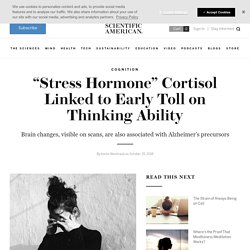
The study of more than 2,000 people, most of them in their 40s, found those with the highest levels of the stress-related hormone cortisol performed worse on tests of memory, organization, visual perception and attention. Higher cortisol levels, measured in subjects’ blood, were also found to be associated with physical changes in the brain that are often seen as precursors to Alzheimer’s disease and other forms of dementia, according to the study published Wednesday in Neurology. The link between high cortisol levels and low performance was particularly strong for women, the study found. But it remains unclear whether women in midlife are under more stress than men or simply more likely to have their stress manifested in higher cortisol levels, says lead researcher Sudha Seshadri. Live imaging of synapse density in the human brain.
The human brain is often said to be the most complex object in the known universe, and there’s good reason to believe that it is.
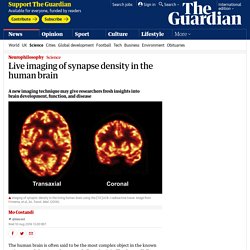
That lump of jelly inside your head contains at least 80 billion nerve cells, or neurons, and even more of the non-neuronal cells called glia. Between them, they form hundreds of trillions of precise synaptic connections; but they all have moveable parts, and these connections can change. Neurons can extend and retract their delicate fibres; some types of glial cells can crawl through the brain; and neurons and glia routinely work together to create new connections and eliminate old ones.
3D model of a nerve terminal in atomic detail. The electrochemical jelly inside your head contains something like one quadrillion synapses, the junctions at which nerve cells talk to one other by converting electrical signals into chemical ones and then back again.
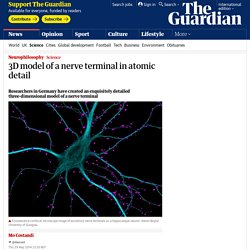
They have two components (sometimes three): the nerve terminal of one cell, which stores and releases neurotransmitter molecules, and the ‘post-synaptic’ membrane of another cell, which contains binding sites for the neurotransmitters.
Brains Operating Differently. Chemic.ally Assets. Imagi.nation. Integrat.ably. Memor.ability. Multiply Intelligences. Psycho.logic to read. Gamification. Medicari. Real.IT Augmentations. SCIENCES. Brain. Brain.